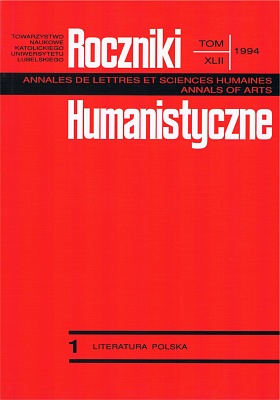„The Miracle of the Vistula” Images of the Polish Soviet War of 1920 in the Popular Drama of the 1920s
Abstract
The paper seek to show a peculiar a peculiar phenomenon of dramatic writing in the 1920s in Poland which phenomenon consisted in a number of plays devoted to the problems of the Polish-Soviet war. Peace solutions after World War One did do away with trouble spots, especially on the eastern border. The victory Tukhachevsky in Byelorussia and of Budenny in the battle of Równe totally threatened Poland as well as all civilized Europe. The breakthrough was brought about in the night of 14-15 August 1920 in the battle of Warsaw. National awareness has called it „the miracle of the Vistula” ascribing the triumph to the intervention of Mary the Queen of the Polish Crown. The battle has come into national mythology. Two images of the war have shaped two types of works: manorial scenes and battle scenes. The first ones make use of the form of comedy where landowners' idyll is occassionally disturbed by the tragedy of war and melodramatic lives of particular heroes. The mansion is an archetype of Polishness, a refuge of Christian ethics, family, social and human shelter. That is why it is the primary object of attacks. Then it is usually saved from destruction by a quick action of uhlans.
The second image is an image of folk, universal war which specifically draws on to dramatic chronicles, historical and batalistic scenes, linking them with a vaudeville. The myth of independency in the previous century moulds the image of the contemporary historical event. Its most important element being the romantic spirit of irredenta. The idea of independency is connected with the idea a bulwark of Christianity. The knights of Mary aand Christianity set off for battle as they did many centuries before.
Both types of dramas depict the Polish-Soviet war as the space of miracle. The history of Poland has again been imbued with holiness. The symbol of a cross in the hands of a priest unites the sacrifice of a nation with the sacrifice of Christ. Unexpectedly this secondary liturgy, reviving the 19th-century myth of independency, has created room for innovatory productions of the greatest Polish romantic and neoromantic drama, especially Mickiewicz's „Dziady”, Z. Krasiński's „Nieboska komedia” and T. Miciński's „Kniaź Patiomkin”.
Copyright (c) 1994 Roczniki Humanistyczne

This work is licensed under a Creative Commons Attribution-NonCommercial-NoDerivatives 4.0 International License.





